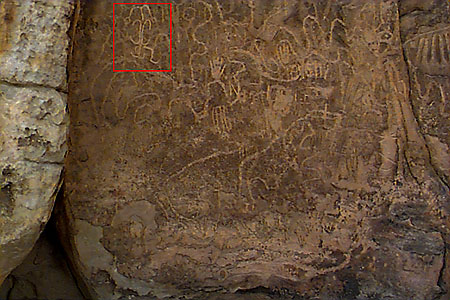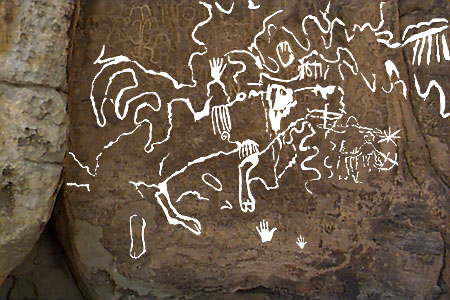
|
The Mystery of Ancient America's
ViewZone will attempt to give you all the details. Our map also directed us to look for a wall that contained "writing" that was atop a high mound of earth (< -- see photo). Being about 30 feet above the canyon floor, the mound was the only way to reach this wall. As we approached it, we could see what was perhaps the most prolific collection of petroglyphs confined to a small, 25 foot long and ten foot high portion of the wall. We were directed to look for a group of symbols at the top left of the wall. Although they did not appear to be related to the Thamudic writing they were certainly odd and worth photographing.  The Wall itself contained layer upon layer of petroglyphs, such that it was impossible to discern any shapes or symbols with the naked eye. It seemed as if the wall had been used for some purpose over an extremely long period of time and that petroglyphs were drawn over faded petroglyphs for centuries. The wall was so interesting that we took many shots of it - something that would prove to be a stroke of luck when we processed them on the computer later in the evening.  The precision with which the hoofed feet and the proportions of the elk were drawn were very different from the stick figures of the Plains Indians. It also appeared that this mural was related to the odd symbols we had seen that did not appear to be Thamudic. Could we have discovered a yet older culture that inhabited this region? We noted that the right antler was artistically extended to encompass the right half of the wall (not visible in photos above). Several slash marks appeared to have been made by repeatedly scarring a portion of the antler with a sharp object or objects. Again, these scars appeared to have been made over a long period and at different times, perhaps by different individuals. Could this have been a ritualistic image that hunters used to sharpen their spears before the hunt? Could the slashes be recordings of successful hunts? Again we could only guess. We left the canyon with more questions than answers. Our map directed us to yet another location, some hundred miles away. We wondered what we would find there.
|
